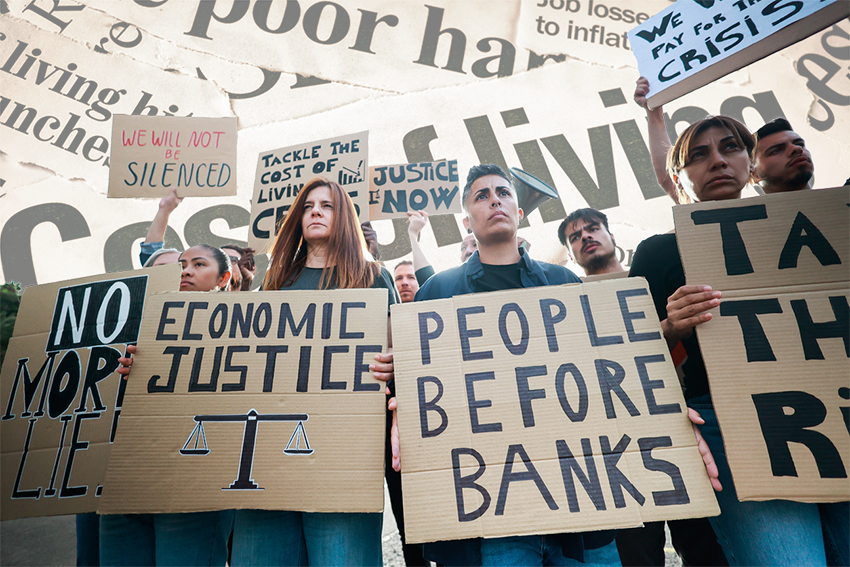Politicians are regularly talking about the Cost-of-Living Crisis as if somehow we will all be led out of the wilderness like Moses and everything will go back to the way it was. New schools of thought say this isn’t so.
The NSW Council of Social Service released its annual Cost of Living in NSW research, investigating cost-of-living pressures for people living below the poverty line and low-income households in NSW.
Undertaken by the Institute of Public Policy and Governance at the University of Technology, Sydney in April of 2023, this research engaged 1,134 NSW residents through an online survey, 23 focus groups, and interview participants.
The report, titled Barely Hanging On: The Cost-of-Living Crisis in NSW explores the experiences across a range of issues such as housing, employment, income and financial hardship. As the report title suggests the findings were grim and it has now been a year since this research was commissioned and little has changed.
Once perceived as a temporary economic anomaly, The Cost-of-Living Crisis has evolved into a persistent, structural feature of contemporary society or the new normal. This shift from a crisis to the new normal is intricately linked with broader systemic challenges that are both local and global in nature.
More recently authors and scientists have been looking at the intersection between, finance, technology and climate change to talk about a new economic reality known simply as the “Meta Crisis”.
The term “Meta Crisis” refers to the interconnected, complex crises that overlap and amplify one another. This complex intersection of finance, technology (and the rise and rise of AI), and climate change presents a multifaceted challenge that will reshape the global economy and force politicians to consider the broader societal implications facing communities, locally and globally.
Author and speaker Daniel Schmachtenberger is the founder of Civilization Research Institute and founding member of The Consilience Project and has extensively explored the concept of the meta-crisis. His work focuses on the interconnected nature of global issues like climate change, economic instability, and technological disruptions, and the religious and even philosophical implications of the Meta Crisis and how these crises interact and amplify one another.
No Longer a Crisis – the New Normal
Traditionally, economic crises were characterised by sudden shocks: financial collapses, market crashes, or sudden inflation spikes. However, today’s cost-of-living crisis manifests as a steady, incremental strain on household finances.
This is due to numerous factors. Wage growth has not kept pace with inflation, particularly in housing, healthcare, and education. This disconnect means that even as nominal wages increase, real purchasing power often declines.
The COVID-19 pandemic highlighted vulnerabilities in global supply chains, leading to shortages and increased prices. While some disruptions have abated, underlying issues remain, exacerbating the cost of living.
Central banks’ responses to inflation have included raising interest rates. While this aims to control inflation, it also increases borrowing costs, impacting mortgages, loans, and consumer spending.
Real estate markets in many regions have experienced dramatic price increases, driven by both speculative investment and limited supply. This trend has made homeownership increasingly unattainable for many.
Understanding Intersectional Challenges
The term “Meta Crisis” refers to the interconnected, complex crises that overlap and amplify one another. The intersection of finance, technology, and climate presents a multifaceted challenge that reshapes the global economy in several ways:
- Economic Disparities: The financialisation of economies has led to growing wealth inequality. Investment in high-yield assets often benefits those already wealthy, while low-income households face financial precarity.
- Debt Levels: High levels of personal and national debt create vulnerabilities. Economic downturns or shifts in policy can exacerbate these vulnerabilities, leading to broader financial instability.
- Automation and Job Displacement: Technologically disruptive advances in artificial intelligence and automation are transforming labour markets. While technology can increase productivity, it also risks displacing workers, particularly in low-skilled sectors.
- Digital Divide: Access to technology varies widely, impacting economic opportunities. Those without adequate digital infrastructure or skills face exclusion from emerging economic benefits.
- Environmental Costs: Climate change has very tangible economic impacts, from damage to infrastructure due to extreme weather events to increased insurance costs and resource scarcity.
- Transition Costs: Shifting to sustainable practices and renewable energy requires significant investment. While necessary for long-term sustainability, these transitions can impose short-term economic burdens on businesses and consumers.
Global Impact of Temperature Rise
Climate scientists have increasingly warned that a global temperature rise of 2°C above pre-industrial levels could have severe economic consequences and exacerbate the cost-of-living crisis. This threshold, set under the Paris Agreement, is considered a critical tipping point with broad implications for global stability.
A 2°C increase could lead to economic crises and higher living costs in a number of ways including the increased frequency of extreme weather events such as hurricanes, heatwaves, and floods.
Agricultural Disruptions include reduced crop yields with igher temperatures and altered precipitation patterns negatively impacting crop yields. This reduction can lead to higher food prices, contributing to the cost-of-living crisis. Regions that are already vulnerable, such as parts of Africa and South Asia, could face even more severe food shortages, leading to both humanitarian and economic crises.
Climate change also exacerbates water scarcity by altering precipitation patterns and increasing evaporation rates. Reduced water availability can impact agriculture, industry, and daily life, driving up costs for water and related products.
Coastal cities face increased flooding risks, leading to property damage, higher insurance costs, and potential displacement of communities.
Higher temperatures ultimately will drive up energy consumption as demand for cooling increases. This surge in energy demand can strain power grids, increase energy prices, and contribute to overall higher living costs.
Increased frequency of natural disasters can lead to higher insurance premiums and reduced availability of coverage. This shift can place a greater financial burden on individuals and businesses, further straining economic stability.
The economic effects of climate change are often felt most acutely by low-income and vulnerable populations. Rising costs for essentials like food, water, and housing can exacerbate existing inequalities, making it more difficult for these groups to cope with the cost-of-living crisis.
Climate-induced disruptions to global supply chains can lead to volatility in commodity prices and economic instability. For instance, disruptions in the supply of key resources can affect global markets, leading to increased costs and economic uncertainty.
Intersecting Impacts on the Global Economy
Countries and communities that adapt to these challenges with robust social safety nets, innovative policies, and investments in green technologies may fare better. Resilience strategies include investing in education, diversifying economies, and fostering inclusive growth.
Effective policy responses are crucial. Governments must balance short-term relief with long-term sustainability. This involves crafting regulations that address financial risks, promote technological equity, and mitigate climate impacts.
Addressing these challenges requires international cooperation. Global supply chains, climate change, and technological advancements transcend national borders, necessitating collaborative solutions and shared responsibilities.
The cost-of-living crisis, now entrenched as the new normal, reflects deeper, systemic shifts within the global economy. The meta crisis framework reveals how finance, technology, and climate intersect to create complex, interconnected challenges.
Understanding these dynamics is essential for developing effective strategies to navigate and mitigate the impacts of this new economic reality.
As societies adapt, the focus must remain on fostering resilience communities, promoting equitable growth, and ensuring that policy responses address both immediate needs and long-term sustainability.













